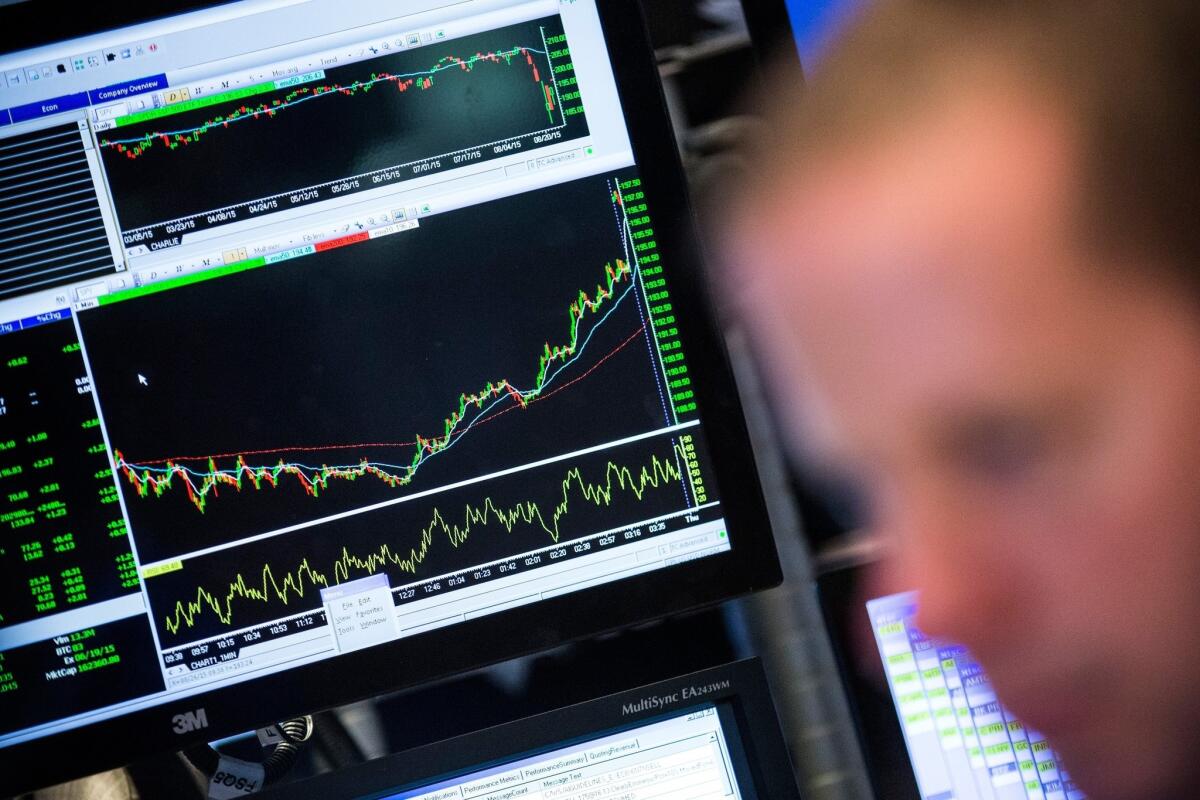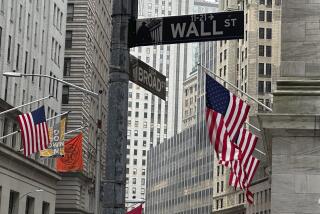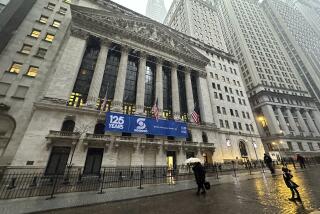U.S. stocks jump again, fueled by strong economic news and rallies abroad

A report of robust U.S. economic growth in the second quarter helped fuel a two-day rally on Wall Street. Above, a trader at the New York Stock Exchange on Thursday.
Stocks in the U.S. rose sharply Thursday for the second consecutive day as a market that has whipsawed investors all month took its cues from surprisingly strong economic news as well as earlier rallies in Chinese and European shares.
The strong rebound — the Dow Jones industrial average gained nearly 1,000 points in two days — follows a gut-wrenching month that saw plummeting stock values worldwide and a volatility not seen in four years. In the previous six straight sessions, the Dow shed a total of 1,879 points, or 11%.
A key factor in Thursday’s gains was a report of unexpectedly robust U.S. economic growth in the second quarter, an encouraging sign that economic momentum was building before the turmoil in financial markets.
The nation’s output of goods and services expanded at a 3.7% annual rate in the second quarter, much faster than the 2.3% rate initially estimated last month by the Commerce Department.
Markets also got a boost from energy stocks, which rose on a jump in crude-oil prices.
The Dow gained 369.26 points, or 2.3%, to 16,654.77 after soaring 619 points Wednesday. The broader Standard & Poor’s 500 index rose 2.4%, and the Nasdaq composite index, the only one to turn positive for the year, gained nearly 2.5%.
Stocks have been clawing their way back after the chaotic sell-off that saw the Dow tumble 14.4% from its record high in mid-May in what Wall Street calls a correction, a drop of 10% or more from a recent high.
Yet even as the market has rebounded, it’s been subject to wild swings.
On Thursday, the Dow initially jumped as much as 381 points early, lost nearly all of its advance in the afternoon and then rallied back in the final hour of trading. And Tuesday, it shot up 442 points before late selling sent it 205 points into the red.
Analysts said the whipsawing market can rattle investors but is not unusual.
“Today was perfectly normal in the process of a correcting market because of the high volatility,” said Greg Ghodsi, managing director of investments at the 360 Wealth Management Group of Raymond James Financial.
“You don’t go down 1,000 points and the problem ends in one day,” he said. “It takes time to work through that.”
Still, “it’s downright astounding” how the market’s major indexes have improved “considering how they started on Monday,” said Pat O’Hare, chief market analyst at the investing website Briefing.com.
Stocks worldwide fell into deep hole this month mainly on fears of a slower-growing Chinese economy and clumsy moves by its leaders to manage the country’s currency and markets. As China’s markets plummeted, they took the world’s indexes with them.
Thursday’s rally, though, rippled throughout the world. China’s benchmark Shanghai composite index gained 5.3%. And key indexes gained 1% to 3% in Japan, Germany and France.
The Federal Reserve, meantime, is reviewing economic data here and abroad to determine whether to raise its benchmark interest rate, which has been at near zero for almost seven years.
That data would include Thursday’s upward revision in the second quarter’s gross domestic product, or total economic output. The increase was even higher than what most economists had expected.
That was mostly because of stronger business investments and the best percentage increase in state and local government expenditures in nearly 14 years.
The second quarter marked a solid acceleration from the weak economic activity in the first three months of this year, when severe winter weather and a labor-related slowdown at West Coast ports reduced GDP growth to an annual rate of just 0.6%.
“The economy regained a massive amount of momentum in the second quarter,” said Paul Ashworth of Capital Economics. “All the evidence from July’s activity and employment data suggests that momentum continued into the third quarter.”
Some of the pickup in the second quarter came from a bigger buildup of inventories, which could take a little bite out of the current quarter’s GDP as companies draw down their merchandise. But there have been some positive indicators in the third quarter as well, including gains last month in orders for durable goods, such as cars and washing machines.
Despite China’s slower growth, which also has triggered further declines in commodity prices, readings thus far show U.S. consumer confidence holding up. Home building, which has been lackluster during most of the recovery, also is improving.
Consumer spending, which accounts for about two-thirds of U.S. economic output, was the biggest driver of growth in the second quarter, contributing 2.1 percentage points of the 3.7% gain in GDP. This was nearly double the first quarter.
Real disposable income — income after taxes and adjusted for inflation — increased just 1.3% in the second quarter, only a third of the growth in the first quarter.
Consumer spending, however, should benefit from lower oil prices and the steady gains in jobs.
Oil prices had fallen more than a third this year to below $40 a barrel for several days this week. But they jumped Thursday amid reports of heavy buying by short sellers who earlier had placed bets that prices would keep dropping.
Light crude oil for near-term delivery, which had been trading around six-year lows, jumped $3.96 to $42.56 a barrel on the New York Mercantile Exchange.
The short sellers were forced to cover as oil prices drew strength from the Commerce Department news on GDP as well as a report in the Wall Street Journal that Venezuela contacted the world’s main oil cartel — the Organization of Petroleum Exporting Countries — for an emergency meeting aimed at propping up global prices.
Peltz reported from Los Angeles; Lee from Washington.
SIGN UP for the free California Inc. business newsletter >>
Boeing’s Southern California layoffs could affect subcontractors
Netflix to double its L.A.-area office space with move to Hollywood
Unstable market could cut the flow of venture capital to start-ups








